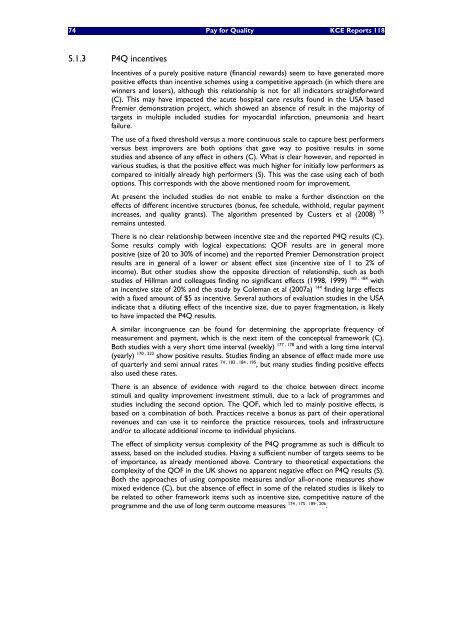Pay for Quality
Pay for Quality
Pay for Quality
You also want an ePaper? Increase the reach of your titles
YUMPU automatically turns print PDFs into web optimized ePapers that Google loves.
74 <strong>Pay</strong> <strong>for</strong> <strong>Quality</strong> KCE Reports 118<br />
5.1.3 P4Q incentives<br />
Incentives of a purely positive nature (financial rewards) seem to have generated more<br />
positive effects than incentive schemes using a competitive approach (in which there are<br />
winners and losers), although this relationship is not <strong>for</strong> all indicators straight<strong>for</strong>ward<br />
(C). This may have impacted the acute hospital care results found in the USA based<br />
Premier demonstration project, which showed an absence of result in the majority of<br />
targets in multiple included studies <strong>for</strong> myocardial infarction, pneumonia and heart<br />
failure.<br />
The use of a fixed threshold versus a more continuous scale to capture best per<strong>for</strong>mers<br />
versus best improvers are both options that gave way to positive results in some<br />
studies and absence of any effect in others (C). What is clear however, and reported in<br />
various studies, is that the positive effect was much higher <strong>for</strong> initially low per<strong>for</strong>mers as<br />
compared to initially already high per<strong>for</strong>mers (S). This was the case using each of both<br />
options. This corresponds with the above mentioned room <strong>for</strong> improvement.<br />
At present the included studies do not enable to make a further distinction on the<br />
effects of different incentive structures (bonus, fee schedule, withhold, regular payment<br />
increases, and quality grants). The algorithm presented by Custers et al (2008) 75<br />
remains untested.<br />
There is no clear relationship between incentive size and the reported P4Q results (C).<br />
Some results comply with logical expectations: QOF results are in general more<br />
positive (size of 20 to 30% of income) and the reported Premier Demonstration project<br />
results are in general of a lower or absent effect size (incentive size of 1 to 2% of<br />
income). But other studies show the opposite direction of relationship, such as both<br />
studies of Hillman and colleagues finding no significant effects (1998, 1999) 183 , 184 with<br />
an incentive size of 20% and the study by Coleman et al (2007a) 144 finding large effects<br />
with a fixed amount of $5 as incentive. Several authors of evaluation studies in the USA<br />
indicate that a diluting effect of the incentive size, due to payer fragmentation, is likely<br />
to have impacted the P4Q results.<br />
A similar incongruence can be found <strong>for</strong> determining the appropriate frequency of<br />
measurement and payment, which is the next item of the conceptual framework (C).<br />
Both studies with a very short time interval (weekly) 177 , 178 and with a long time interval<br />
(yearly) 170 , 222 show positive results. Studies finding an absence of effect made more use<br />
of quarterly and semi annual rates 74 , 183 , 184 , 195 , but many studies finding positive effects<br />
also used these rates.<br />
There is an absence of evidence with regard to the choice between direct income<br />
stimuli and quality improvement investment stimuli, due to a lack of programmes and<br />
studies including the second option. The QOF, which led to mainly positive effects, is<br />
based on a combination of both. Practices receive a bonus as part of their operational<br />
revenues and can use it to rein<strong>for</strong>ce the practice resources, tools and infrastructure<br />
and/or to allocate additional income to individual physicians.<br />
The effect of simplicity versus complexity of the P4Q programme as such is difficult to<br />
assess, based on the included studies. Having a sufficient number of targets seems to be<br />
of importance, as already mentioned above. Contrary to theoretical expectations the<br />
complexity of the QOF in the UK shows no apparent negative effect on P4Q results (S).<br />
Both the approaches of using composite measures and/or all-or-none measures show<br />
mixed evidence (C), but the absence of effect in some of the related studies is likely to<br />
be related to other framework items such as incentive size, competitive nature of the<br />
programme and the use of long term outcome measures 174 , 175 , 189 , 206 .
















